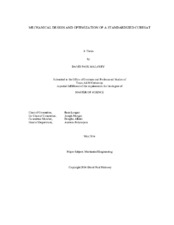| dc.description.abstract | Cubesats are tiny space exploration vessels with a lower cost than most satellites in history. Rapidly, studies are taking place on this technology to the degree that published papers on cubesats seem to have doubled between the initial background study and thesis completion. These satellites have a multitude of purposes and missions but all conform to one small physical form factor. The research presented here aims to create a cubesat mechanical design that is flexible enough to accommodate varying payloads and is fed by a multidisciplinary design optimizer in order to make best use of the limited volume of the craft.
The study consists of the development of a simplified math model of the satellite and subsystems, 3D model with FEA analyses based on successful past designs, and the creation of a real prototype using a CNC mill along with measures taken to reduce time and cost of prototyping. The results of the optimization suggest that a cubesat is a valid candidate for an optimizer which uses both heuristic and gradient based algorithms.
The optimizer first finds the satellite design with the lowest mass to meet the mission criteria while satisfying constraints on propulsion, electrical power, and structure strength. The design is a product of six variables (propellant, thruster valve, structure material, solar panel quantity, battery quantity, and structure thickness). Following the problem of mass minimization, cost is introduced in a dual objective optimization and a Pareto front of design options is generated.
Prototype development resulted in major improvements to prototyping speed and cost for the conditions at hand. The methodology and assumptions shown enhance the argument that these conditions are conservative with respect to most cubesat design requirements including strength, and manufacturing cost, and other metrics. Both the optimizer and the modular prototype of the spacecraft maintains an ability to manipulate the design in future iterations to offer an effective standardized platform.
Throughout this thesis, key lessons are shared and weaknesses and uncertainties are identified. Finally, future work is offered on this research topic which would enhance the effectiveness and certainty for success in full cubesat design implementation. | en |


